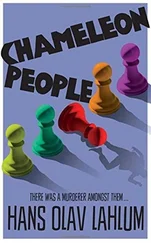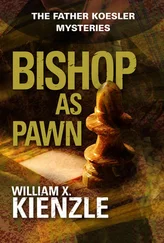William Kienzle - Chameleon
Здесь есть возможность читать онлайн «William Kienzle - Chameleon» весь текст электронной книги совершенно бесплатно (целиком полную версию без сокращений). В некоторых случаях можно слушать аудио, скачать через торрент в формате fb2 и присутствует краткое содержание. Жанр: Криминальный детектив, на английском языке. Описание произведения, (предисловие) а так же отзывы посетителей доступны на портале библиотеки ЛибКат.
- Название:Chameleon
- Автор:
- Жанр:
- Год:неизвестен
- ISBN:нет данных
- Рейтинг книги:5 / 5. Голосов: 1
-
Избранное:Добавить в избранное
- Отзывы:
-
Ваша оценка:
- 100
- 1
- 2
- 3
- 4
- 5
Chameleon: краткое содержание, описание и аннотация
Предлагаем к чтению аннотацию, описание, краткое содержание или предисловие (зависит от того, что написал сам автор книги «Chameleon»). Если вы не нашли необходимую информацию о книге — напишите в комментариях, мы постараемся отыскать её.
Chameleon — читать онлайн бесплатно полную книгу (весь текст) целиком
Ниже представлен текст книги, разбитый по страницам. Система сохранения места последней прочитанной страницы, позволяет с удобством читать онлайн бесплатно книгу «Chameleon», без необходимости каждый раз заново искать на чём Вы остановились. Поставьте закладку, и сможете в любой момент перейти на страницу, на которой закончили чтение.
Интервал:
Закладка:
Meyer breathed a prayer of thanksgiving that assistants were not invited to staff meeetings. He wouldn’t have to witness Cletus Bash browbeating some pretty nice people. The ironic thing was that due partly to Bash’s pomposity and partly because the people he would be talking down to were some fundamentally decent human beings, they’d probably not challenge any of his ridiculous opinions.
Well, come to think of it, thought Meyer, I didn’t challenge him either. Never mind that Meyer studiously avoided confrontation in order to maintain financial security and a considerable investment in a retirement fund. In the end there was no question about it: Bash got away with too much-far too much.
Koesler, like the others in the room, had no idea of what Bash and Meyer had been discussing.
Meyer it was who had saved a place for his boss. This came as no surprise to Koesler, He had met Meyer often enough to know it was almost impossible to get a firm opinion from the man. He was all questions and very few answers. That he would arrive at a place like this early enough to save a seat for his boss was to be expected. Meyer had made a science of kowtowing. Koesler found that sad.
But, Koesler wondered, what could Clete Bash mean by saying he could have killed a story? What story?
No one who read the local papers, watched local TV, or listened to local radio could be unaware that Father Cletus Bash was, for starters, the official spokesman for the archdiocese of Detroit. Indeed, faidiful readers, viewers, and listeners could be forgiven for being fed up with Bash’s intrusion when it came to news stories. It was as if there could be no Catholic news or Catholic reaction to news unless Cletus Bash did it or said it.
But what could he have meant by saying that he could have killed a story? Surely not this story. He must have had reference to some other story.
Koesler dismissed the whole business.
He would have been distracted in any case by a sudden stirring in this overly crowded and overly warm room. Archbishop Lawrence Foley was making an entrance. There was no possible doubt about that whatever.
Foley had a distinct-nay, unique-way of clearing his throat. He would half bury his chin in his clerical collar, cover his mouth with a closed fist, and clear his throat with a series of rumbling sounds.
The cough was the result of a combination of causes, including nearly fifty years of cigarette smoking, inveterate tea drinking, and, eventually, sheer habit. While he had quit smoking some ten years ago, his hack sounded as authentic as if he had just walked off a tobacco plantation.
Five years ago he had retired as archbishop of Cincinnati. The stated reason for his retirement was his age-seventy-and ill health. Both reasons were real enough, but the more pressing issue was that in some Curial circles he was considered “soft” on such issues as homosexuality and abortion. Foley wasn’t really an advocate of either practice. He just loved everybody-including sinners and those considered by highly placed authorities to be sinners. The longer he lived, the more accepting and nonjudgmental he became-attributes not at all prized by the present administration in Rome. However, a few years before, Rome itself had been burned by the reaction of American bishops when a liberal West Coast bishop had his local authority shredded by some bureaucrats in Rome. Not wishing to be twice burned, yet not willing to endure any hint of doctrinal deviation, Rome had applied considerable pressure as Foley neared compulsory retirement age.
The archbishop, a loyal churchman despite his humanistic leanings, complied with Rome’s wishes. He retired, but stayed on in a private Cincinnati home as bishop-emeritus. However, despite his striving to maintain a very low profile, his popularity remained strong. He was invited to meetings of such fringe groups as former priests, and women who demanded ordination. Often, he attended. The good man had great difficulty refusing invitations, particularly those from people who were hurting.
Pressure was applied again: this time, to leave Cincinnati and the people with whom he’d built a long-standing, mutual love affair.
Obediently, he packed. But where to go? He prayed. His prayers were answered almost ideally by an invitation to reside in Detroit.
Detroit had become known throughout the country and the entire Catholic world as an “open” diocese. The Second Vatican Council had hit Detroit harder than any other U.S. diocese and certainly no less forcefully than any other diocese in the world.
Rome was not enthused by the Detroit Syndrome. But there were some substantial if subtle differences between Detroit and Cincinnati. Detroit’s archbishop, Mark Boyle, was a Cardinal, a “prince of the Church,” That, plus Boyle’s popularity among his confreres, had earned him the first elected presidency of the newly formed U.S. Bishops’ Conference. Even Rome had to take these facts into consideration.
There were also differences between Boyle and Foley.
Larry Foley’s conscience and conviction led him to more or less sympathize with the spirit of the fringe and outlawed groups with whom he dealt. Mark Boyle, on the other hand, seldom if ever swerved from the vera doctrina , the true doctrine as interpreted by Rome.
Boyle’s great virtue-or flaw, depending on which side of the fence one sat-was his ability to co-exist with those whose opinions he did not share. Without shouting, “Off with their heads!”
Thus Boyle got along with Foley as well or better than with just about any other bishop in captivity. They had been friends for years; it was only natural that Foley had considered Boyle’s invitation to reside in Detroit as heaven-sent.
With this background, Koesler understood why Archbishop Foley would receive mixed reviews from the people in this room. Many of them had the “bureaucratic mind” that disapproved of Foley as a maverick, while others appreciated him to the extent of loving him.
Among the latter was Sister Joan Donovan. While making no effort to conceal the details of her sister’s life and death, she had, with anxiety, let her wish be known that her sister receive a Catholic burial.
Archbishop Foley had been the first-and, actually, the foremost-to respond to her appeal. He told Joan it would be an honor for him to preside over the Mass of Resurrection and burial. Thus Sister Joan joined the long line of those beholden to him.
Foley was here to lead the rosary. To that purpose he now made his way toward the front of the room where a kneeler had been placed before the bier.
The archbishop gave new meaning to fragility. Thin as a pipe cleaner, he was slightly stooped. Although he bore a generally dour face topped by wispy white hair, it was his eyes that distinguished him. They were blue and danced with merriment.
Even the soft whispering gradually ceased as Foley shuffled to the front of the room. As he reached the casket, Sister Joan stepped forward and joined him. For several moments they stood gazing at the remains of Helen Donovan. Foley had spoken words of consolation at the time he’d agreed to preside at the funeral, so there was no need to go into that again.
“She was very beautiful,” Foley said finally. He had never met Helen Donovan in life.
Joan nodded, “She looks quite natural. I was told the bullet entered the rear of her head and didn’t come out. So I guess there was no extensive damage in the front to …” She choked back a heavy pressure in her throat.
“… repair?” Foley supplied.
“Yes, that’s right.”
Foley joined his hands as if in prayer. “Now that I’ve finally seen her, I am amazed how much she resembles you.”
“Oh, she was much prettier.”
“No, not really. She’s lovely, of course. But then, so are you.”
Читать дальшеИнтервал:
Закладка:
Похожие книги на «Chameleon»
Представляем Вашему вниманию похожие книги на «Chameleon» списком для выбора. Мы отобрали схожую по названию и смыслу литературу в надежде предоставить читателям больше вариантов отыскать новые, интересные, ещё непрочитанные произведения.
Обсуждение, отзывы о книге «Chameleon» и просто собственные мнения читателей. Оставьте ваши комментарии, напишите, что Вы думаете о произведении, его смысле или главных героях. Укажите что конкретно понравилось, а что нет, и почему Вы так считаете.












